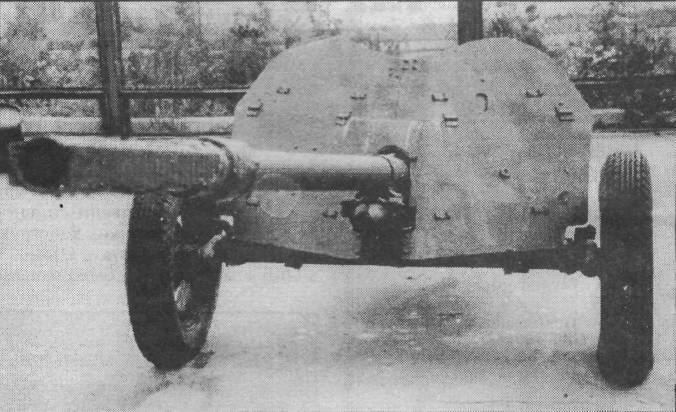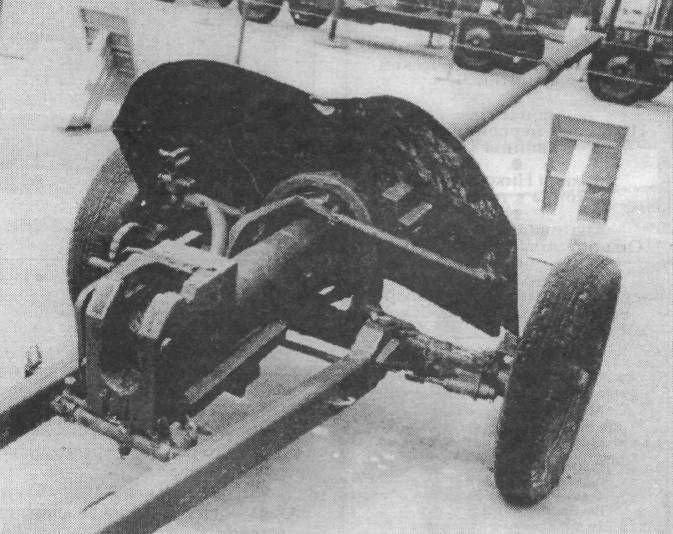Post-war anti-tank artillery. 57 mm anti-tank gun M16-2
In the design bureau of the plant number 172 according to the requirements in 1946, the 57-mm16 anti-tank gun was designed.
The barrel of the gun was a monoblock with a screw breech and a muzzle brake. In the muzzle brake of high power on the length of 600 millimeters there were 20 pairs of windows that were cut at an angle of 49 degrees to the channel axis. The muzzle brake of the M16 cannon was performed at the same time as the barrel, in the M16-2 - separately, a key was used for the connection. The muzzle brake channel in both cases had rifling that was a continuation of the rifled part of the barrel bore. The muzzle brake absorbed about 72% energy.
The recoil devices were installed in a tubular cradle, while the cradle pipe was the hydraulic nakatnik cylinder and the hydraulic knuckle cylinder served as a hydraulic brake cylinder.


The anti-tank gun was equipped with a sector-type lifting mechanism, and a screw-type pushing mechanism. Sliding bed box type. Torsion suspension. The shield consisted of a sheet that is set at an angle of 45 degrees, two folding upper shields and a folding lower shield.
OP1-2 was used as a direct sight.
The wheels from GAZ-A are regular with a GK tire and a lightweight hub.
Field tests of a prototype of this gun were carried out on the HAP during the period from October 28 to December 4 of the 46 year. Tests on the 544 shot stopped because of the significant curvature of the muzzle brake, which was performed with the barrel in one piece. In addition, there was a lack of strength of the bed, as well as a strong pitching of the barrel, which occurs after the shot.
After the test, the prototype was refined and, under the symbol M16-2, was sent to the main artillery ground for re-tests conducted from July 14 to September 2 47 of the year, together with the 57-mm 4-26 anti-tank gun.
During ground tests, the M16-2 anti-tank cannon made 1235 shots, of which an 865 armor-piercing projectile, 265 fragmentation and a sub-caliber 105. During repeated field tests, the insufficient strength of the lower and upper machines, the unreliable operation of the trigger mechanism and the shutter, the unsatisfactory operation of the recoil device, the instability of the system during firing, and so on were identified. The commission’s revision of the M16-2 anti-tank gun was inappropriate. Soon work on the M16-2 completely stopped.
Comparative ballistic data of the X-26 and М16-2, obtained at the main artillery range in July-August of the 47 year:
The BR-271 armor-piercing projectile weighing 3,14 kg (charge weight - 1,425 kg) released from the M16-2 gun had an initial speed - 978,2 m / s, from the H-26 gun - 976,2 m / s;
Fragmentation projectile O-271U mass 3,75 kg (charge weight - 0,913 kg) released from the gun M16-2 had an initial speed - 685,5 m / s, from the gun H-26 - 680 m / s;
The sub-caliber projectile BR-271P weighing 1,79 kg (charge weight - 1,655 kg) released from the M16-2 cannon had an initial speed of 1238 m / s, and from the H-26 gun - 1245 m / s.
The anti-tank gun M16-2 has the greatest firing range at an angle of + 15 °; the fragmentation projectile is 6556 meters, and the gun H-26 - 6520 meters.
Specifications lightweight anti-tank gun M16-2:
Caliber - 57 mm;
Sample - 172 plant;
Full length of the barrel - 4175 mm / 73,2 CL;
Channel length - 3358 mm / 58,9 CL;
The length of the threaded part - 2853 mm;
The slope of the rifling - 30 CLB;
Volume of a chamber - 2,05 l;
The number of grooves - 24;
Cutting depth - 0,9 mm;
Cutting width - 5,35 mm;
Field width - 2,1 mm;
Shutter weight - 20,0 kg;
Barrel weight with bolt - 333,5 kg;
Vertical tilt angle — from -5 ° 40 'to + 15 ° 40';
Vertical pickup angle - 58 °;
The recoil length is normal - 650 mm;
Limit rollback length - 680 mm;
The height of the line of fire - 598 mm;
The length of the gun with shifted beds - 6500 mm;
The width of the gun when the beds are moved apart - mm 3860;
The width of the guns with shifted beds - 1730 mm;
Stroke width - 1520 mm;
Shield thickness - 6 mm;
Wheel diameter - 770 mm;
Weight of sliding parts - 352 kg;
The weight of the swinging part - 425,9 kg;
Shield weight - 62 kg;
The weight of the mast without a shield and guns - 406 kg;
The weight of the system in the combat position - 797 kg;
Rate of Fire - 10-20 rpm;
The speed of carriage on the highway - 60 km / h.
Information